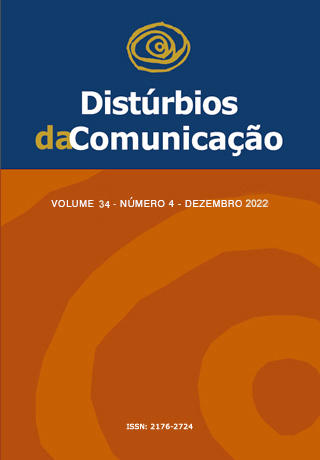Dysphonia
portrait of a population group in the city of Guarulhos
DOI:
https://doi.org/10.23925/2176-2724.2022v34i4e56561Keywords:
Dysphonia, Voice, Larynx, LaryngoscopyAbstract
Introduction: Dysphonia impacts in quality of life and in the labor market, being an important symptom for screening laryngeal neoplasia. Objective: Perform a statistical evaluation of a population group in the city of Guarulhos complaining of dysphonia. Method: This is a cross-sectional study using a sample corresponding to 2,564 examinations, videolaryngoscopic or nasofibrolaryngoscopic, of patients over 5 years of age, in the municipality of Guarulhos of the metropolitan region of São Paulo, by the same ENT physician and the same speech therapist, between April 2011 and April 2012. Changes in voice diagnosis were evaluated taking into account the age and gender of the patient. The sex of subjects was described according to diagnoses using absolute and relative frequencies, and the existence of an association between sex and diagnosis was verified through the use of likelihood ratio testing (Kirkwood and Sterne, 2006). Ages were described according to diagnoses using summary measurements (mean, standard deviation, median, minimum and maximum), and compared the ages between diagnoses, using variance analysis (ANOVA) followed by multiple comparisons by Tukey (Neter et al., 1996). The tests were performed with a significance level of 5%. Results: There is a higher frequency of men diagnosed with neoplasms or cancer than in other diagnoses. Of the 2,564 tests, 477 had chronic laryngitis, 69% in females; 279 functional dysphonia, 63.4% female; 137 minimal structural alterations (AEM), 69.3% female; 36 neurological dysfunctions, being equally divided between genders; and 12 presented neoplasms, 83.3% in males. Conclusion: There were a higher number of benign alterations in the female gender. Neoplasms and neurological dysfunctions predominated in males. Functional dysphonia and AEM occur in patients under 40 years of age, while the others occur even at advanced ages, above 50 years of age.
Downloads
References
Souza LF. Perfil epidemiológico dos pacientes com disfonia do Hospital Universitário da UFSC [TCC]. 2014. Florianópolis: Universidade Federal de Santa Catarina; 2014.
Fortes FSG, Imamura R, Tsuji DH e Sennes LU. Perfil dos profissionais da voz com queixas vocais atendidos em um centro terciário de saúde. Rev Bras Otorrinolaringol. 2007; 73(1): 27-31.
De Melo ECM, Mattioli FM, Brasil OCO, Behlau M, Pitaluga ACA, De Melo DM. Childhood dysphonia: Epidemiological aspects. Rev Bras Otorrinolaringol. 2001; 67(6): 80477.
Freitas MR, Pela S, Gonçalves MLR, Fujita RR, Pontes PAL, Weckx LLM. Disfonia crônica na infância e adolescência: estudo retrospectivo. Braz J Otorhinolaryngol. 2000; 66(5): 480-4.
Tratado de otorrinolaringologia, 117 Disfonia: Classificação, Diagnóstico e Tratamento| Shirley Shizue Nagata Pignatari, Wilma Terezinha Anselmo-Lima.
Wünsch V. The epidemiology of laryngeal cancer in Brazil. São Paulo Med J. 2004; 122(5): 188-94.
Hoffman HT, Karnell LH, Funk GF, Robinson RA, Menck HR. The National Cancer Data Base report on cancer of the head and neck. Arch Otolaryngol Head Neck Surg. 1998; 124(9): 951-62.
Altman KW. Vocal fold masses. Otolaryngol Clin North Am. 2007 Oct; 40(5): 1091-108.
Watts SL, Brewer EE, Fry TL. Human papillomavirus DNA types in squamous cell carcinomas of the head and neck. Oral Surg Oral Med Oral Pathol. 1991; 71(6): 701-7.
Vaezi MF, Qadeer MA, Lopez R, Colabianchi N. Laryngeal cancer and gastroesophageal reflux disease: a case-control study. Am J Med.; 119(9): 768-76.
Tulunay OE. Laryngitis--diagnosis and management. Otolaryngol Clin North Am. 2008; 41(2): 437-51.
Woodson G. Management of neurologic disorders of the larynx. Ann Otol Rhinol Laryngol. 2008; 117(5): 317-26.
Behlau M, Pontes P. Avaliação e tratamento das disfonias. São Paulo: Lovise; 1995.
Ramig L, Halpern A, Spielman J, Fox C, Freeman K. Speech treatment in Parkinson’s disease: Randomized controlled trial (RCT). Mov Disord. 2018; 33(11): 1777-91.
Sulica L, Louis E. Essential voice tremor. In: Merati AL, Bielamowicz SA, eds. Textbook of laryngology. San Diego, CA: Plural Publishing; 2006.
Behlau M, Gasparini G. Classification Manual for Voice Disorders-I - CMVD-I. Rev Soc Bras Fonoaudiol. 2007; 12(1): 72-5.
Braga JN, Oliveira DSF, Atherino CCT, Schott TCA, Silba JC. Nódulos vocais: análise anátomo-funcional. Rev CEFAC. 2006; 8(2): 223-9.
Paul BC, Chen S, Sridharan S, Fang Y, Amin MR, Branski RC. Diagnostic accuracy of history, laryngoscopy, and stroboscopy. Laryngoscope. 2013; 123(1): 215-9.
Guimaräes V de C, Viana MA do DESR, Barbosa MA, Paiva ML de F, Tavares JAG, de Camargo LA. Vocal care: Question of prevention and health. Cienc e Saúde Coletiva. 2010; 15(6): 799-803.
Instituto Brasileiro de Geografia e Estatística (IBGE). XXXX [internet]. 2020 [citado em: 2020 ago 30]. Disponível em: https://cidades.ibge.gov.br/XXXX/XXXX/XXXX/pesquisa/23/25888.
Lima MFB. Sintomas vocais, alterações da qualidade vocal e laríngea em professores: análise de instrumentos [Dissertação]. 2008. São Paulo: Pontifícia Universidade Católica de São Paulo; 2008.
Costa B, Cielo CA, Siqueira MA. Lesões de borda de pregas vocais e tempos máximos de fonação. Rev CEFAC. 2009; 11(1): 134-41.
Cielo CA, Gonçalves BFT, Lima JPM, Christmann MK. Afecções laríngeas, tempos máximos de fonação e capacidade vital em mulheres com disfonia organofuncional. Rev CEFAC. 2012; 14(3): 481-8.
Menoncin LCM, Jurkiewicz AL, Silvério KCA, Camargo PM, Wolff NMM. Alterações musculares e esqueléticas cervicais em mulheres disfônicas. Arq Int Otorrinolaringol. 2010; 14(4): 461-6.
Levy D, de Almeida LM, Szklo A. The Brazil SimSmoke policy simulation model: the effect of strong tobacco control policies on smoking prevalence and smoking-attributable deaths in a middle income nation. PLoS Med. 2012; 9(11): e1001336.
Instituto Nacional do Câncer (INCA). Câncer de laringe. 2016 [citado em 2021 nov 20]. Disponível em: https://www.inca.gov.br/tipos-de-cancer/cancer-de-laringe.
Downloads
Published
Issue
Section
License
Copyright (c) 2023 Ieda Millas, Fernanda Fidalgo Dias, Márcia Helena Moreira Menezes, Daniela Imbrosio Cantisano, Ana Luiza Vieira Soares

This work is licensed under a Creative Commons Attribution 4.0 International License.









